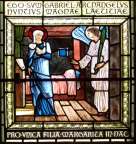Sir Edward Burne-Jones' stained glass window The Annunciation in St Margaret's Church stands apart from Burne-Jones' other stained glass works in many ways. The depiction of Gabriel and Mary — clad in flowing, colored robes — is consistent with the other stained glass works' style, but the scene and setting are more reminiscent of Dante Gabriel Rossetti's The Girlhood of Virgin Mary and Ecce Ancilla Domini. The window illustrates the annunciation scene, with Gabriel holding palms and entering Mary's bedroom and saying (in Latin) "I am the Archangel Gabriel, a messenger of great joy." Mary's facial expression in Burne-Jones' The Annunciation resembles her expression in Rossetti's oil painting of the same event. Mary's posture in the Burne-Jones version is markedly less dramatic than in Rossetti's because she is standing near her bed, not cowering on it.
The detail of the indoor setting is striking. Nearly all of Burne-Jones' stained glass works are set outside or lack a distinct setting, but The Annunciation features a detailed indoor scene — complete with two-point perspective. The green curtain on the left of the scene and the window above the bed indicate a conscious attempt to create a sense of depth in this stained glass work that is rarely seen in traditional works found in churches. The resulting effect is a sense of terrestrial setting that is often absent in the grand and less-literal depictions of other biblical scenes.
The inscription below the scene, which reads "For my only daughter Margaret," adds another dimension of human connection to the illustration. Whether or not the connection is intentional, the text's suggestion of a comparison between Margaret and the Virgin Mary enables empathy for Mary that would otherwise be lost in a stylized, abstract illustration of the scene.
Questions
1. The blue robe Mary wears in The Annunciation is unremarkable, but her red halo stands in rather striking contrast to palette of softer colors frequently used to depict Mary. Is the choice of color for the halo symbolic or merely aesthetic?
2. Is Mary's face modeled off of Margaret Burne-Jones' face?
3. The book opened on the stand behind Mary is reminiscent of the books stacked on the floor in The Girlhood of Virgin Mary and runs into the same question of potential anachronism. Does the book serve a typological purpose in the scene? What does it suggest about Mary?
4. Is there any indication of the role Morris and Co. may have had on the final work, as a piece of art, during the manufacturing process? Are there any records of Burne-Jones' original conception before it was translated into glass?
Last modified 10 March 2008
